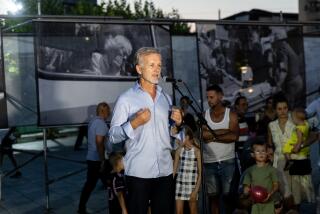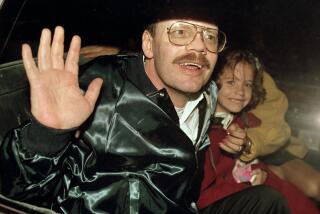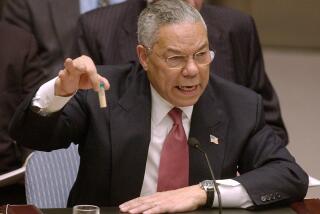U.S. Forces Blamed in Death of British Journalist
- Share via
LONDON — U.S. forces unlawfully fired the heavy-caliber machine-gun bullet that killed British newsman Terry Lloyd after an Iraqi civilian put him in his car and attempted to take him to the hospital when he was wounded shortly after the U.S.-led invasion of Iraq in 2003, a coroner ruled Friday.
After an eight-day inquest that included testimony from Lloyd’s cameraman at ITN News, Oxfordshire Deputy Coroner Andrew Walker said he had “no doubt” the shooting was “an unlawful act,” and concluded that Lloyd could have survived an earlier attack by Iraqi forces had U.S. soldiers not opened fire on his rescue vehicle.
Walker said he would ask senior British legal officials to hold those responsible criminally liable, but U.S. authorities denied wrongdoing and said the Marines deployed in southern Iraq during the early days of the war were following the rules of engagement.
“The Department of Defense has never deliberately targeted noncombatants, including journalists,” the Pentagon said in a statement. “We have always gone to extreme measures to avoid civilian casualties and collateral damage.”
U.S. officials declined to provide troops to testify at the inquest, and the coroner refused to accept what he said were anonymous “self-serving statements.” No U.S. explanation was part of the inquest’s official deliberations.
Lloyd’s family called the shooting a “very serious war crime,” and said the evidence showed that the newsman was able to stand and walk until he was shot in the head by U.S. troops while lying in the back of a minibus that had stopped to help him.
“This was not a ‘friendly fire’ incident or a crossfire incident. It was a despicable, deliberate, vengeful act, particularly as it came many minutes after the initial exchange” between U.S. military forces and Iraqi troops, Lloyd’s widow, Lyn, said in a statement read by her lawyer.
“U.S. forces appear to have allowed their soldiers to behave like trigger-happy cowboys in an area where civilians were moving around,” she said.
Unlike many journalists who were traveling with American forces at the beginning of the war, Lloyd and his crew were operating near the southern Iraqi city of Basra on their own, a strategy many journalists believed would allow them to get a more impartial view of the war.
They had set out to survey the area when they inadvertently moved past U.S. tanks toward a line of Iraqi soldiers, who began chasing the journalists through Iraqi and American gunfire.
“All hell broke loose, absolutely,” Lloyd’s Belgian cameraman, Daniel Demoustier, testified at the inquest.
Moments later, he said, “I turned my head to the right and saw the passenger door was open and Terry was not in the car anymore.”
Lloyd’s Lebanese interpreter, Hussein Osman, was killed, and French cameraman Fred Nerac is missing.
Both were seized by Iraqis and put in a pickup, witnesses said.
Ballistics experts said Lloyd was hit first with a bullet fired by an Iraqi, but he would have survived had he not been hit by a second bullet fired from a U.S. tank that pierced the side of the minibus.
Walker, the deputy coroner, said the evidence led him to believe that U.S. tanks opened fire first on the two marked TV trucks and the Iraqi vehicle that had intercepted them.
He said U.S. troops opened fire on the minibus even though “it presented no threat to American forces.”
The Pentagon said its investigation looked only at the shots fired at the minibus.
“Combat operations are inherently dangerous, and we do not take lightly our responsibilities in the conduct of these operations,” the Pentagon said.
“We do not, nor would we ever, deliberately target a noncombatant civilian or journalist.”
More to Read
Sign up for Essential California
The most important California stories and recommendations in your inbox every morning.
You may occasionally receive promotional content from the Los Angeles Times.










